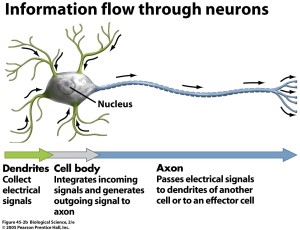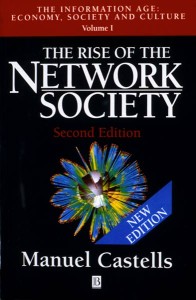I’ll start this week with the readings on neurobiology because of my interests in that field. I’m actually quite fond of making references to mind mapping and neurobiology when looking for metaphors to explain critical thinking or other complex activities (whether for my own use or for my students – pity them). I’m sure this has to do with my life-long interest in the sciences, so it’s only natural I gravitate toward such analogies as black holes, synaptic connections, neural networks, and – of course – the Borg.

The Borg, Star Trek: The Next Generation
from Memory Alpha.org
While reviewing these materials, I was struck by the overt parallels with our theories covered thus far in terms of networks and network activities: nodes = neurons, boundaries = cell membranes, and neuron-to-neuron transfer = over gaps. So now that it’s clear that both these filters are permanently seated as my reading lenses, these connections – and their links to some of our theorists and our theme – take on a new level of profundity when linking out to ways my classroom pedagogy (and my Object of Study) can be articulated with the help of this week’s readings / concepts.
In sum, this chapter provides an overview of how the brain’s neurons essentially constitute networks within networks, part of the higher brain function – what the textbook refers to as a systems-level operation. These neurons process and transmit electrical impulses and chemical information as part of knowledge generation, transfer, memory, and a host of physiological functions. The description is vividly reminiscent of the chained activity system described by Spinuzzi, except that these neural pathways seem anything BUT “informal linkages” (Spinuzzi “Networks” 74). The textbook section on Neurobiology parallels many of our recent discussions and, of course, Castells’ preliminary chapters outlining a history of knowledge development (a knowledge economy). Our brains take in information, process that information, and then create some product our “outputs” (“Introduction”). With advancing technology such as imaging systems, researchers are able to examine knowledge at the molecular level, observing exactly how “neurons talk” by comparing the process to a “24-hour call center” (reminding me of Activity Theory). (This change of perspective remains that of an observer – something our previous week’s discussion pressures thanks to our attention to the Observer vs. Integrated Participant roles we as humans play within an ecosystem.) The specific nodes in this “talking process” that strike me as most compelling and connection-rich are the concepts of “voltage-gated channels” (buses come to mind), “LTP,” and the system of movement / boundaries / and mediators that is the neuron.
I found several of the key vocabulary terms as defined by the glossary important to both this summary and my OoS theory:
- Neuron = a cell referred to as a type of “battery” which collects and transfers information. Key to communication in cellular activity. In essence, we might see it as an activity node. Two ends, one for reception, one for delivery/transfer. Neurons “make the connections” (Neurobiology video).
- Dendrite = found on the neuron’s surfaces, akin to a “tree” structure, these receive chemical/electrical messages
- Axon = found at the opposing end of the neuron, transmits the processed incoming signal to other neurons
- Membranes = cell barriers, surfaces
- Synapses = what connects two neurons in order to exchange information
- Receptors = receiving the molecular information, on a “post-synaptic neuron,” before transferring on the information.
- Neurotransmitters = molecules that travel “across the synapse and, by binding to the receptor on the postsynaptic neuron,” key to signal transfer
- Exocytosis = when neurotransmitters are released
- Vesicles = described like a “soap bubble,” nodes of transmission for the neurotransmitter. The boundaries or membranes essentially carry the information, serving like a moving truck for the information.
- LTP or Long Term Potentiation = key to memory. If a neuron is hyper stimulated, say with increased sensory stimuli like neurons become “more sensitive to stimuli.” It has to do with the pre-synaptic and post-synaptic connections. Rather than a synchronous 1:1 pre- post- activity, increased input or stimulation increases the firing duration. This might happen because more neuro-transmitters are released. Or, the receptor is modified somehow (chemically), increasing the action potential.
- Neurogenesis = a key to adaptation. Apparently the adult brain holds “in reserve” new / potential neurons, contrary to what was previously believed to be limited to early brain development which ceases at a certain maturation stage. New technologies revealed that the brain isn’t as much like a computer – with limited input / data potential – as once believed. Interestingly, this was discovered by looking at the gaps – examining activity that suggested another force was in play (Foucault’s traces).
- Voltage-gated channels = either open or closed, “membrane potential of the cell,” by chemicals like neurotransmitters. These occur in the cell membrane of the neuron. Essentially, the charged electronic particles (ions) move according to the gradients of the charge (positive moves toward negatively charged areas and vice versa). These channels might be seen as communication avenues, or conditions with a culture that permits (as Castells might argue) potential energies to move information from the local to the global (xxxv) in a “space of flows” (xxxiii).

The dendrites are in green; the axon is in blue. Taken from http://www.uic.edu/classes/bios/bios100/lectures/nervous.htm.
The textbook chapter’s focus is on neurobiology, and specifically neuron activity and transfer. The video mentions “molecular to global perspectives,” creating a possible node of connectivity with our ecology readings of past weeks, as well as Castells’ discussion of economics. In fact, there is simply so much here that resonates as a potentially powerful metaphor for our exploration of networks, especially those that involve human agency (a link to ANT certainly). The environment of the ecologies discussed last week seem to parallel in many ways with the process of neurogenesis. Changes in the environment (or ecology) affect the nature of the brain circuitry. Behavior and the brain combine, effects moving in both directions. Behavior regulates the response by the brain to the environment, as well as the reverse. Such “two-way” transmission results in transformation, not unlike the systems described by Castells when he explores ways in which “major social changes” – or our environment – are “characterized by a transformation of space and time in human experience” (xxxi), perhaps what might create what he calls a “space of flows” within a networked society (xxxiii).
Castells’ primary focus appears to be an explanation of what he calls “a new form of society, the network society” which is a culture “based on multimodal communication” (xvii). Rather than providing us another theory, Castells asserts that this is a “structural analysis” (xix) – much like what we read in the Neurobiology Textbook. What is learned? Certainly a host of new terms, but also a means of examining familiar concepts in new ways…concepts such as knowledge, communication, connections, and structures.
Castells’ preface mentions the idea of “mega nodes” (xxxviii), an interesting concept of concentrated power, nodes that serve as switching points in the global network or system of economies. Castells seems to argue that these mega nodes – usually concentrated intersections located at “points of connection in this global architecture of networks” which “attract wealth, power, culture, innovation, and people” – are places of convergence or intersections that are not only geospatial but economic (xxxviii). The function of these mega nodes remind me of a TED video about “filter bubbles” as these mega nodes act as directional potential for those at the farthest reaches of this system, exerting control much like the LTP of the synaptic connections might function. Castells argues that “our societies are…structured around a bipolar opposition between the net and the self,” creating a “structural schizophrenia between function and meaning” (3). His opening chapter (chapter 1) explores the history of technology in terms of a revolution similar to the industrial revolution – what he calls the “information technical revolution” (29). Essentially, information technology is akin to the new energies of the Industrial Revolution” (30). The “pervasiveness” of information technology is woven into everything and “the mind is a direct productive force” in this system, not simply something that “makes decisions in the ‘system’” (31) The computers then become extensions of the mind, and this is where the neurobiology readings intersect, for the neuroscientists now see the computer analogy for our brain’s functioning no longer sufficient – it’s far more complex. Castells’ early chapters also reveal a complexity to which the neurobiology readings create an interesting parallel – or overlay – in the ways that such systems function. Since Castells pointed out early in his book that he was not trying to create a theory, only a structural analysis…even so, it still feels like a theory, given his references to economic/political powers tracing the creation of nodes and driving innovation into the pattern of the system (Chapter 1) and the existence of a “new culture” (xvii).
In fact, it is this local to global framework which pairs so well with the neurobiology textbook reading, especially since Castells is apparently locating his discussion of economies within communication — specifically an economy based on information. He points to agency nodes, “material foundations of the network society,” that point back to our readings on ecology, and even as far back to Activity Theory and Actor Network Theory. In many ways, Castells’ early chapters illustrate the foundations of a network system that seems to move much like neurons and neurotransmitters do.
It’s all really heady stuff (no pun intended), and its grounding in information being communicated seems to connect in complex ways with the complex neurobiology model we read this week. It may take me a while to process all of this – but there is so much potential applications to studying MOOCs here, I’ll likely need to sift through it to pick and choose.
In the meantime, all this talk of brains and neurochemistry has led me to one of my favorite movie scenes. Perhaps an appropriate reminder of how we must sometimes tread carefully when working with networks and nodes.



One Response to An Ecology of Reading Notes: Castells & Neurobiology, or NeuroEco